By Lucy Komisar
Sept 1, 2019

Court says Magnitsky‘s arrest for tax evasion justified
“The Russians had good reason to arrest Sergei Magnitsky for Hermitage tax evasion” said the European Court of Human Rights on Tuesday, Aug 27, 2019. That is a major admission by a western institution.
The Court decision also describes terrible medical care that everyone acknowledges contributed to the death of the Russian accountant jailed for his collaboration in a major tax evasion crime.
But then it makes a judgment based on no evidence that is hard to explain outside a political Russophobic attack.
Bruises on wrists and ankles could come from beatings
Magnitsky who died of pancreatitis and related diseases had bruises on his wrists and ankles. “The Court considers that the injuries could have arguably been received as a result of beatings by prison officers.”
“Could have” is not a usual basis for a court decision. Such bruises of course, based on accepted autopsy reports, could not have caused his death. And there is no evidence they were inflicted by prison officers.
But they became the reason for a Court finding that “Taking into account the intentional character of the ill-treatment (not proved), the nature of the injuries (bruises) and the level of suffering (obviously from illness) to which [Magnitsky] was subjected, the Court finds that the act of violence in question amounted to inhuman and degrading treatment.”
Except there was no act of violence cited and proved.
European Court of Human Rights: a political agency of the West

The ECHR was established by the European Convention on Human Rights in 1998 by the 47 member states of the Council of Europe. This judgment raises questions about whether it is really an independent court or a political agency of the West.
The case the Court ruled on was filed by Sergei Magnitsky and his wife and mother and promoted by William Browder, who ran a hedge fund in Russia and was convicted of evading multi-millions of dollars in taxes.
Magnitsky was the tax accountant who handled Browder‘s tax evasion and was arrested for it in 2008. After nearly a year in prison, in bad conditions and lacking proper medical care for serious illnesses, he died. The claim was continued by his widow and mother.
Ten years later, in a period of renewed Cold War attacks by the West on Russia, the Court ruled on accusations by the Magnitsky family that he was one way or another killed by the Russians. When you parse the judgment, it says Magnitsky was arrested for cause, he got bad care in prison and then – and this is the dicey part, because it is not backed by evidence – his death is related to a beating by guards that left bruises on his wrists, ankles and legs.
Nothing is said about head or torso. No evidence is provided that there was such a beating, just powerful suggestions that bruises on his wrists and ankles meant he was beaten to death.
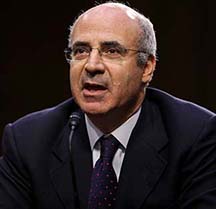
William Browder, the convicted tax fraudster, goes on to spin the story as a great victory. It really isn‘t, except in a PR sense. That is because it‘s unlikely western reporters will read the tax evasion part of the judgment. Or seek evidence about the death. The hurriedly published report by the BBC was egregiously flawed.
A horrendous editorial by the Washington Post was even worse. (Where is the Post’s fact-checker who should be awarding his colleagues multiple Pinocchios?) I sent the Post a documented oped reply which I assume will not be published! (I will post it here.)
Here are the main take-aways from the decision, some of which were based on evidence, some based on Russophobic conclusions. Note that the Court uses the Magnitskiy spelling, while I write the more common U.S. usage, Magnitsky. You will see both.
THE TAX EVASION
Court gets right that Magnitsky was rightfully arrested
On November 24, 2008, the police searched Magnitsky‘s Moscow flat and took him to appear before the investigating authority. The Court: On the same day he was arrested on suspicion of having assisted tax evasion and placed in police custody in Moscow.
Documentary evidence & statements by people who did sham work for Browder‘s companies
The Court said: “The accusations were based on documentary evidence relating to the payment of taxes by those companies and statements by several disabled persons who had confessed to sham work for the two companies. One of them testified that he had been in contact with Mr Magnitskiy, had received money from him and had assisted him in finding other sham employees. He also said that Mr Magnitskiy had told him what to say if questioned by the authorities and had asked him to participate in a tax dispute as a witness.”
- The sham was to say that these disabled workers were Browder‘s employees so he could get a big tax write-off.
The next day an investigator interviewed him initially as a suspect, and then as an accused. He was charged with two counts of aggravated tax evasion committed in conspiracy with Mr Browder in respect of Dalnyaya Step and Saturn. [They were two shell companies Browder set up in Russia to hold the shares he bought.]
During the interview Magnitsky argued that he had neither prepared nor submitted tax declarations on behalf of those companies, that he had not arranged for the employment of the disabled persons and that they had not pretended to work, but had actually worked for the companies.
- That was a lie, as he had organized the fake operation, and the workers named him. Browder admitted to the scam in his 2015 U.S. court deposition.

The Court observe[d] that the inquiry into alleged tax evasion, resulting in the criminal proceedings against Mr Magnitskiy, started in 2004, long before he complained that prosecuting officials had been involved in fraudulent acts.
The Court observes that the inquiry into alleged tax evasion, resulting in the criminal proceedings against Mr Magnitskiy, started in 2004, long before he complained that prosecuting officials had been involved in fraudulent acts.
The Court concluded that Magnitsky‘s arrest was not arbitrary, and that it was based on reasonable suspicion of his having committed a criminal offence.
Court: Arrest after Magnitsky planned to flee the country
The decision to arrest him was made after investigating authorities noted that during a tax inquiry which had preceded the criminal investigation, Mr Magnitskiy had influenced witnesses, and that he had been preparing to flee abroad. In particular, he had applied for an entry visa to the United Kingdom and had booked a flight to Kyiv. He was a flight risk.
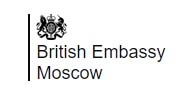
Later, seeking to get him out of prison, Magnitsky‘s lawyer presented a letter from the British Embassy in Moscow stating that the Embassy had no record of a visa request being submitted by or granted to the first applicant. A Russian court dealing with a request to end Magnitsky’s detention said the letter was not signed, and the Court indicates no challenge to that.
Court wrong on search of Browder‘s offices and tax refund fraud
The Court said, “In May 2007 the investigation department of the Ministry of the Interior in Moscow opened criminal case no. 151231 into tax evasion allegedly committed by the head of Kameya Limited, also a client of Hermitage.”
* This distorts fact that investigation into tax evasion started in 2002-3 in Kalmykia and then was transferred to Moscow after Browder bribed local officials to drop it!
“On 4 June 2007, in the course of the investigation into the activities of Kameya, several officers from the investigation department, including officer K., searched the Moscow offices of Firestone Duncan and those of Hermitage‘s advisers, Hermitage Capital Management. Among other items of evidence, they seized corporate documents and company seals not related to Kameya.”
Hermitage Capital Management challenged the search in a complaint to the Moscow Prosecutor‘s Office. Major Ka.‘s refusal to return any of the seized documents led to the filing of further complaints by Firestone Duncan.
¢ Why should it? It was evidence. When does an investigative authority give back evidence to suspects?
On 16 October 2007 Hermitage‘s subsidiaries received letters from a joint-stock company called Logos Plus informing them that on 30 July 2007 a commercial court had transferred the ownership of the three subsidiaries to another company and that Logos Plus had lodged claims against them for billions of Russian roubles with reference to that judgment.
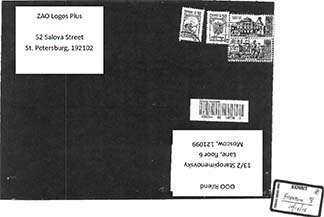
* This evades the fact that Hermitage received legal letters at their old mailboxes about the lawsuits leading to transfer of ownership in July, not October. These were mailboxes accessed by Magnitsky. Exhibits to prove this were filed in U.S. federal court in the Prevezon case.
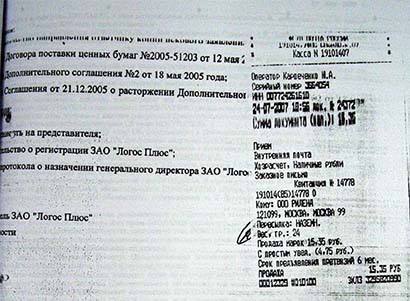
The claims were part of the tax refund fraud, a scam against the Russian Treasury that some sophisticated criminals figured out on behalf of crooked clients. The racket was based on collusive lawsuits.
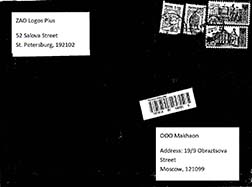
The operators would set up shell companies, sue their clients‘ companies, and the defendants would accept the demands and agree to pay out large sums. Then they would deduct the amounts from their profits – usually it equaled 100% of profits — and demand refunds of taxes paid.
This was done in 2007 using three Hermitage shell companies, Parfenion, Rilend and Makhaon.
Some half a dozen fake lawsuits were filed against the companies in July 2007. They claimed almost $1 billion in damages. In Russia, the plaintiff and the court notify the defendant by registered mail. The notice is signed by the defendant, and the lawsuit proceeds. The receipts and envelopes of registered letters show they were sent by a plaintiff to the companies‘ old addresses where they would have been picked up by Magnitsky. One, shown here, was sent July 24th 2019 to Rilend at 13/2 Staropimenovsky Lane, Moscow, its address before the alleged theft and re-registration of the companies.
The decision says, “Following the discovery of these legal developments, lawyers acting on behalf of the subsidiaries complained to the chair of the Investigative Committee of the Prosecutor General‘s office, the Prosecutor General and the head of the Department of Internal Affairs of the Ministry of the Interior. The complaints contained accusations against the police officers, in particular officer K. and Major Ka., who had seized the documents and seals and had allegedly used them to perpetrate the fraud.
The lawyers stated that the re-registration of the three subsidiaries in the name of new owners and the commercial court proceedings against them had been unlawful. They asked the authorities to open a criminal investigation into the misappropriation of the three subsidiaries.
* This is a lie. First, the exhibits prove they got notice of the suits in July. And there were no accusations against officers. On December 3, 2007, more than four months after receipt of the legal letters, Browder‘s lawyer Edouard Khairetdinov filed a complaint, not about the theft of the companies but about an attempt to steal money from them. Though Browder would later say the companies had no assets. That meant they had been already been stripped to avoid their being attached for back taxes.
* Then the judgment says that, “On 5 June 2008, in an interview with the special investigator, [Magnitsky] made statements pertaining to the change of ownership and the tax refund in relation to the three subsidiaries, including the alleged criminal misconduct and abuse of office by officer K. and Major Ka.”
* That is a lie. He didn‘t in any of his three interrogations accuse the officers. The testimonies are online, easy for the Court to read.
Court take on Magnitsky‘s conditions of detention: some true, some false
Magnitsky had complained of poor conditions, overcrowding, cells with not enough beds, poorly lit and ventilated, deplorable sanitary conditions. Showers only once a week, daily walks of an hour in a small prison yard, food of extremely poor quality.
* This is most likely true. It describes prison conditions in the U.S. and many other countries. Russian prisons are not like those in Scandinavia. I’m not aware that the Court routinely takes cases based on rotten prison conditions, including in politically friendly countries.
A doctor‘s report describes Magnitsky becoming aggressive, saying “now they will kill me” and running around inside the cell area. They call for guards and eight arrive at about 7:30 pm. She calls for a psychiatric first-aid team. The guards put on handcuffs. An entry in the medical record at 7 p.m. says “acute psychosis and delirium of persecution”. Guards later testify handcuffs were removed half an hour later when Magnitsky had calmed down and his behavior had returned to normal. This is also reported by the Moscow Public Oversight Commission, which did the only independent report of Magnitsky in prison.
The judgment says: “Two official documents, recording that handcuffs and a rubber truncheon had been used, were prepared at the time. The first report signed by officer Kuz. indicated that at 7.30 p.m. Mr Magnitskiy had been handcuffed to prevent suicide or self-harm. The second report signed by the same officer and two witnesses stated that officer Kuz. had used a rubber truncheon against the first applicant to prevent suicide or self-harm. Both reports were approved by the head of the detention facility. Later, officer Kuz. and witnesses to the events claimed that a rubber truncheon had not been used and that it had been mentioned in the report because of a typing error.”
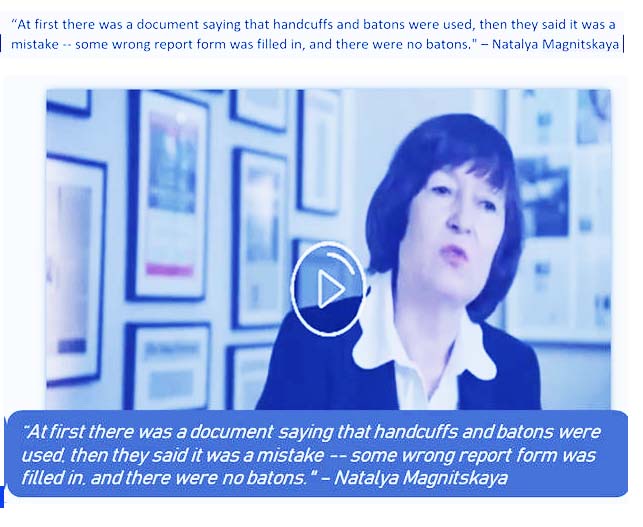
* This turns out to be the basis of a fabrication by Browder that Magnitsky was beaten to death by eight riot guards over 1 hour and 18 minutes. It was never corroborated by anybody, including by autopsy reports. It was even initially denied by Magnitky‘s mother in a video interview. But it was adopted by the Russophobic West.
* Here is what the Court says: “A prison medical record drawn up by the prison surgeon stated as follows:
“at 9.15 p.m. [Mr Magnitskiy] was examined again owing to the worsening of his condition. During an examination performed by psychiatrists the patient lost consciousness. A prison medical assistant started resuscitation (closed-chest cardiac massage, artificial ventilation …).”
According to this record, at 9.20 p.m. the first applicant was transferred to a special medical ward in building no. 7, where for thirty minutes prison staff, including Dr A.G., continued their unsuccessful attempts to revive him. He was declared dead at 9.50 p.m. that evening.”
The death confirmation certificate said the patient had died at 9.50 p.m. on 16 November 2009 owing to toxic shock and acute cardiovascular insufficiency. It gave the following diagnosis:
“Cholelithiasis. Acute calculous cholecystitis. Acute pancreatitis. Pancreonecrosis? Acute psychosis. Closed craniocerebral injury?”
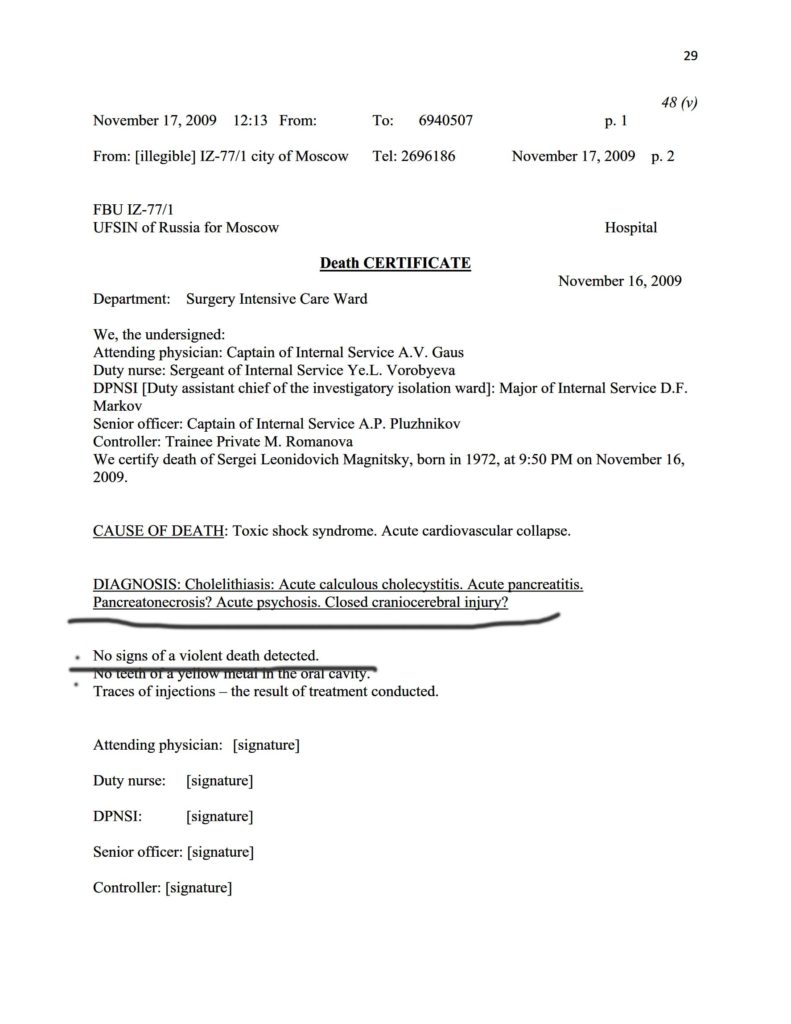
The Court chose not to include the line, No signs of a violent death detected. In the context of suggesting repeatedly that Magnitsky was probably beaten to death, it cites two lines of medical diagnosis on the death certificate but not the next line which challenges the beating death theory.
Investigation into Mr Magnitskiy‘s death
On Magnitsky‘s death, the Court veers into “probable” and “possible” instead of sticking to provable facts in reports by medical examiners.
From the report by the Centre for Forensic Medical Examinations of the Ministry of Healthcare and Social Development of the Russian Federation: “Having been asked to assess the nature and cause of injuries discovered on the first applicant‘s arms and legs, the experts concluded that they had occurred ante mortem and had resulted from at least five blows with a blunt object or from friction. Those blows could have been caused by a rubber truncheon.”
- There is no indication if the experts had been specifically asked about a truncheon. Or they might just as well have said a stick or a bat. Or if five blows to the leg could be deadly. Or why they were not asked about other blows — except if there were no other blows.
Because it is reported that, “The medical examination had not disclosed any traces of violence on Mr Magnitskiy‘s body, having thus disproved the suspicion that he had been beaten up with a rubber truncheon on 16 November 2009. The injuries on the wrists had been caused by handcuffs, while bruises and abrasions on the left hand, left shin and right ankle had been self-inflicted when Mr Magnitskiy had behaved aggressively. A bruise on the right ankle had appeared three to six days before the death and had been the result of “domestic trauma”. The injuries were minor and had not led to Mr Magnitskiy‘s death.”
And Magnkitsky‘s body is photographed with abrasions on the wrists.
“He had died from acute cardiac failure and cerebral and pulmonary oedema induced by secondary dysmetabolic cardiomyopathy developed on account of diabetes and chronic hepatitis in its active form. Those diseases had not been diagnosed in due time and there was a causal link between Dr L.‘s failure to ensure the necessary medical examinations and Mr Magnitskiy‘s death.”
Magnitskiy‘s autopsy was carried out by a medical assessor from the Forensic Medical Examination Office. Finally, it included a description of the external physical injuries on Magnitskiy‘s body:
– bruises on the left and right wrists inflicted as a result of the squeezing and sliding action of a blunt hard object or objects with a limited traumatising surface shortly before the death;
– bruises and two abrasions on the left hand, and a vertical oval abrasion on the front surface of the left calf also inflicted shortly before the death as a result of the impact and sliding action of a blunt hard object; and
– a bruise on the inner surface of the right ankle joint inflicted three to six days before the death.
- So, everybody sees the same bruises. Wrists, hands, calves, ankles. The medical assessor concluded that the injuries had no causal link to the death.
- So, not beaten to death. But those reports do not appear to sway the Court from its determined conclusions.
The report by an American organization looking at the same evidence is more political. The judgment cites the Physicians for Human Rights of Cambridge, Mass., which conclude that Magnitsky “received inadequate medical attention and assessments in view of the differing diagnoses of his ongoing symptoms. Such neglect had been “calculated, deliberate and inhumane.”
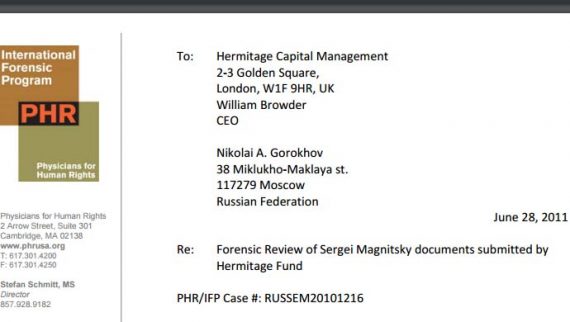
It said, “Complete photographs of the external surfaces of the body, as well as both distant or intermediate-distance and close-up photographs of each injury, had apparently not been taken.”
- That seems odd. A source who had access to Prevezon case evidence told me there is a body photo that shows no bruises, but I have been unable to obtain it.
- But this is related, a point the Court did not take up, perhaps because it didn‘t know. And I don‘t know if PHR knew that the documents it got from William Browder, who commissioned its report, used a translation that was erroneous in a key place.

I contacted Dr. Robert Bux, now retired, who was Chief Medical Examiner at the El Paso County Coroner‘s Office, Colorado Springs, when he wrote the PHR report published in 2011. I spoke to him on the phone and then emailed him this section from the published version of the autopsy report he used, asking him about the parts in English marked “illegible.”
Here in the most significant section of the Russian document is the completely legible text, which can be run through a translator:
Трупные пятна обильные, синюшно-фиолетовые, разлитые, располагающиеся на задней поверхности шеи, туловища, верхних и нижних конечностей, при надавливании на них пальцем исчезают и восстанавливают свою первоначальную окраску через 8 минут. Повреждений на волосистой части головы не обнаружено. Кости лицевого скелета, хрящи носа на ощупь целы. Глаза закрыты.
The English was provided to PHR: Cadaveric rigidity is well expressed in the muscles of masticatory muscle system, in the neck muscles and the limbs. Cadaveric lividities are abundant, livid purple, diffused, located on the back surface of the neck, the body, upper and lower limbs (illegible) not found on the scalp. The bones of the facial skeleton, the nasal cartilages are unbroken to the touch. The eyes are closed.
Then I sent him a translation by a Russian native speaker with the “illegible” parts in bold face, because they were really not illegible in the Russian:
Cadaverous spots are abundant, bluish-purple, diffuse, located on the back of the neck, trunk, upper and lower extremities, when pressed on them with a finger disappear and restore their original color after 8 minutes. Damages are not found on scalp. The bones of the facial skeleton, the cartilages of the nose are intact. Eyes closed.
My translator said: “In Russian cadaverous spots and bruises are completely different words. He said, However, I do not know what it means that they disappear and come back after 8 minutes. I think that bruises would not disappear when pressed on them with a finger.”
Bux declined to comment.
Before I sent the details, Dr. Bux was quite interested in what I had found and said he‘d comment in a few days. After he saw the difference in translations, he declined to reply to emails and phone calls.
The correct translation would show that there were no relevant bruises on Magnitsky’s body. That should have been written in the PHR report. And the PHR report should now be corrected. I sent the information to PHR officials, who declined to address the issue.
Proceedings against Mr Magnitskiy after his death
This deals with whether Magnitsky‘s widow and mother requested a court to consider his guilt in order to clear and rehabilitate him, which is provided by Russian law. The Court says that in November 2009 an investigator discontinued the criminal proceedings against Magnitskiy on account of his death. The widow was informed and told she could appeal.
But then the criminal proceedings against Magnitsky were revived, the government said to protect the interests of the widow and mother who had not consented to the discontinuation of the case, had insisted on the wrongful accusations against Mr Magnitskiy being dealt with and had asked for his name to be cleared.
The Court says in December a lawyer for the family asked authorities to discontinue the criminal proceedings and got no reply. At any event, in July 2011 the case was reopened. The widow protested and refused to answer any questions concerning the merits of the case. The Prosecutor General‘s office rejected her petition. Possibly, Mrs. Magnitsky had asked for the rehabilitation and then changed her mind. Or been persuaded to change her mind. Of course, the family didn‘t want the details of Magnitsky‘s criminal activity public; of course, Russian prosecutors did.
In November 2012 Magnitskiy was accused of tax evasion for having fraudulently claimed through Dalnyaya Step and Saturn $3 million in tax benefits for the employment of disabled persons, and for underpayment by those companies of $14 million through wrongful exemptions from local and regional taxes. The prosecution said the offences were committed in conspiracy with Browder. Those are charges the Court indicates appear to be true.
The case was sent to trial, Magnitsky was found guilty, and the case was dismissed because of his death.
Parliamentary Assembly of the Council of Europe
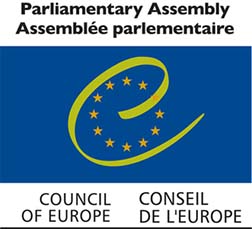
Here the Court includes a document by the Parliamentary Assembly of the Council of Europe, the parliamentary arm of the 47-nation international organization that claims dedication to upholding human rights, democracy and the rule of law. Alas, its report, known as the Gross Report after Andreas Gross, the Swiss member who wrote it, is egregiously fake and does not speak well for the organization that adopted it without evidence or hearings.
It says, “Mr Magnitsky had carried out investigations on behalf of a client on a massive fraud against the Russian fiscal authorities. The suspects he identified had effectively obtained the reimbursement of taxes paid by his client‘s companies, which had been fraudulently re-registered in the names of known criminals.
- That is a fabrication. The report does not supply proof that Magnitsky had investigated anything or identified anybody.
PACE wrote that complaints to Russian law-enforcement bodies were sent for investigation to the same Interior Ministry officials who had been accused of complicity.
¢ Except that nobody had been accused of anything.
PACE said Magnitsky had been placed in pre-trial detention, in increasingly harsh conditions, for alleged tax evasion committed in 2001 together with his then client William Browder.
¢ The Court found that there indeed was tax evasion.
Finally, that Magnitsky was “beaten with rubber batons and died the same evening.”
- Also a lie with no evidence provided.
There were other charges about officials and people Browder implicated in the tax refund fraud traveling together and having extreme wealth, which could just as well be used to implicate Browder and his associates in the crime.
U.S. Federal Judge Pauley says the report is not credible
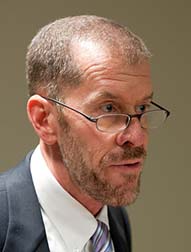
U.S. Federal Judge Pauley answered the PACE report best. Pauley was in charge of the Prevezon case, brought in the U.S. by Browder‘s proxy, the Justice Department, as part of his tax refund fraud red herring to block the Russians from going after his evaded Kalmykia taxes. When in 2017 the Justice Department sought to introduce the report as evidence – though it had nothing to do with the case, was just an attempt to smear the owner of Prevezon who Browder accused of receiving funds from the tax refund fraud – the judge refused on grounds it was lacking credibility and was based only on Browder‘s statements and documents.
Pauley said, There’s no evidence that an actual hearing with the appropriate procedural safeguards was actually conducted. One of the events that may have colored the investigation from the outset is William Browder’s interference with the assembly’s work. Several individuals who were paid and directed by Hermitage to investigate Magnitsky-related events were interviewed by Gross.” He said, In other words, the Gross report is some piece of work and I mean that in hyperbole.” The European judges apparently didn‘t know the views of the American judge.
See my story (with English translation) about the PACE report in the Geneva daily, Le Temps. Other western media bought the PACE fabrications without checking.
The Court considers charges of violent death
The Russians said prison officers had handcuffed Magnitsky on account of his aggressive behavior induced by toxic psychosis. Bruises came from handcuffs or from actions during his psychotic attack, which included knocking a metal couch against metal bars.
But according to the Court, Magnitsky‘s mother “alleged that prison guards had handcuffed and beaten the first applicant with a rubber truncheon several hours before his death. In support of that assertion she relied on, among other evidence, a report of 16 November 2009 prepared by officer Kuz., the death confirmation certificate, and the second medical expert commission report of 15 June 2011. She also cited various inconsistencies and gaps in the explanation of the events by the authorities and alleged that the investigation had not been independent, impartial, prompt or thorough, and had been closed to public scrutiny.
- So how does Magnitsky‘s mother explain her videoed statement to Andrei Nekrasov that her son was not beaten by a baton? The other alleged evidence is also dubious, including the repudiated officer report, the death certificate that says no violence detected and the various vague “possibilities” by experts.
Then the Court says, “There is no dispute between the parties that on 16 November 2009, while in custody, the first applicant sustained several bruises and abrasions on his wrists, hands and left leg. According to the medical experts, the injuries were inflicted by a hard, blunt object. It was not ruled out that that object could have been a police truncheon. Accordingly, the Court considers that the injuries could have arguably been received as a result of beatings by prison officers.”
- Could have arguably? Is that how a court makes decisions of fact? The Court apparently could not find any experts to say that these injuries on wrists and legs could have caused Magnitsky’s death.
The Court says, “The recording of those injuries, as well as of possible head trauma, in the death confirmation certificate, together with the reference in the records to the use of a rubber truncheon, should have raised concerns as to the use of force against” Magnitsky.
- Wait a minute. That is a “closed craniocerebral injury?” That means it was past. And the death certificate shown above says no signs of violence detected. The reference to truncheon is maybe, possible. Raised concerns? What is the Court doing here?
The Court says, “However, this issue was not addressed by the investigating authority. The decision to close the criminal case did not provide any explanation for discarding evidence which supported the allegation of ill-treatment, such as the records on the use of a rubber truncheon and the death confirmation certificate.
- But there was no such evidence, no record of the use of a rubber truncheon. And the death certificate says no signs of violence detected. There was no evidence to discard.
The Court says, “The investigating authority did not make any efforts to elucidate the discrepancies between the available evidence and the conclusions in the decision to close the case, for example between the record in which a prison guard had reported the use of a rubber truncheon against the first applicant and the investigator‘s finding that no special-purpose hardware, save for handcuffs, had been used on Mr Magnitskiy.”
- Because Browder invented that later. Compare his earlier statements with the declaration that eight prison guards had beat Magnitsky with rubber truncheons for 1 hours and 18 minutes. The Court doesn’t wonder about that. Or explain how Magnitsky was killed by five truncheon hits to a leg.
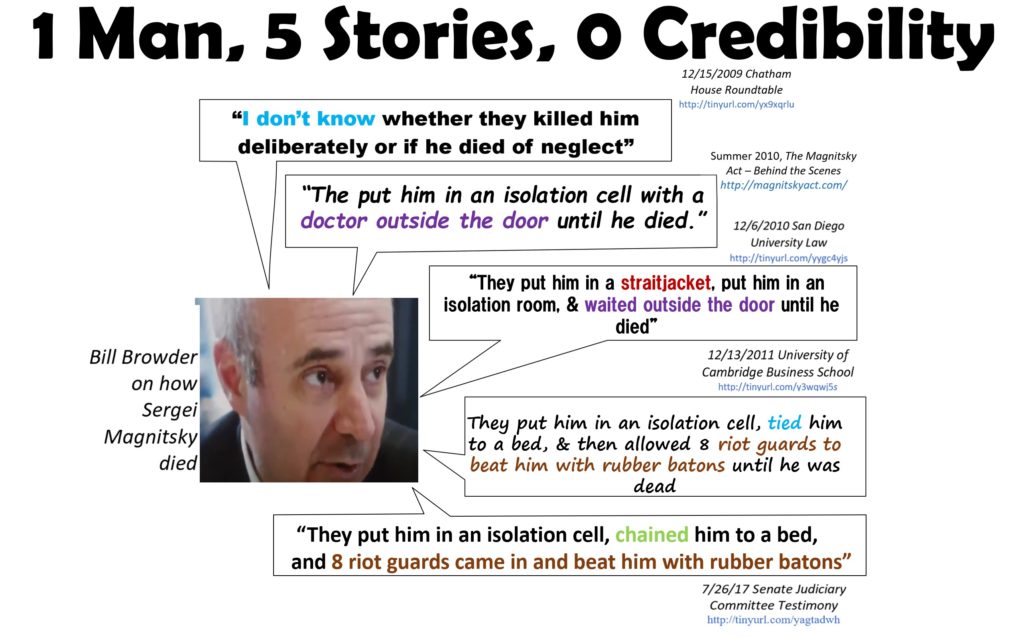
The Court says, “No answer was given to the question as to why the death confirmation certificate mentioned a closed craniocerebral injury.”
- What answer does the Court want. “Closed” means it was past. Why is that not acknowledged? Did the Court see the death certificate that said no signs of violent death?
The Court said it was aware that the domestic authorities addressed at least some of Magnitsky‘s injuries. In particular that the injuries were “self-inflicted during aggressive and inappropriate behaviour”. The Court did not accept that explanation. It said no witness saw him injuring himself, only that he had dashed about in the cell and had hit a medical couch against metal bars. That none of those actions was linked to the possible cause of his injuries.
- Nobody witnessed him being beaten, either.
The Court claims that the investigating authority did not genuinely attempt to shed light on the events which occurred in the hours before Magnitsky‘s death. It therefore found that the investigation was not thorough and effective.
- However, the investigation was done within days by the Moscow Public Oversight Commission, an NGO charged with overseeing prison conditions, certainly more credible to the Court than a government organization. Its report was cited by the Browder-requested report by Physicians for Human Rights.
- So, the Court did not accept the Russians‘ version, which it said lacked proof, or even the Public Oversight Commission‘s report, and instead accepted Magnitsky‘s mother‘s new version, also without proof, that Magnitsky was “subjected to ill-treatment by the guards in the remand prison.”
Finally, “Taking into account the intentional character of the ill-treatment (not proved), the nature of the injuries (bruises) and the level of suffering (not proved) to which the first applicant was subjected, the Court finds that the act of violence in question amounted to inhuman and degrading treatment.”
- What act of violence? Does the Court mean several bruises on wrists and legs? Or the alleged beating (which left no marks on head or torso) that William Browder invented two years after Magnitsky died?
Finally, the Magnitsky widow and mother requested the Court ask Russia to create an independent commission of inquiry into the circumstances of Magnitsky‘s death.
- Fine, except there is no basis for such an inquiry except the Moscow Public Oversight Commission report which says he died of bad medical care. Did they find other evidence ten years later?
- Also to issue a public apology for the denial of justice, though denial of justice against a tax evasion accountant was not proved.
Finally, the Court “holds that there has been a violation of Article 3 of the Convention on account of Mr Magnitskiy‘s ill-treatment by the prison guards and the lack of an effective investigation in that regard.”
- Back to the Moscow Public Oversight Commission report which indicates no ill-treatment aside from bad medical care and crummy conditions for all.
The Court is surprisingly honest about the fact that Magnitsky was arrested on credible charges of participating in Browder‘s tax evasion. It deserves reproof for its conclusion which, ignoring the evidence, charges Russia with violence that it strongly suggests — but never expressly declares much less proves — caused Magnitsky’s death. This must be explained either as slipshod work or Russophobia.
Browder, of course, misrepresented the court’s judgment to the mainstream press, which took down his statements like the stenographers they are. This is filmmaker Andrei Nekrasov’s rebuttal of the misrepresentation of the court’s judgment by Browder and his acolytes. Norway’s ‘Agenda Magasin’, after some negotiations, published the article.


Pingback: Aussie MPs support a tissue of lies to promote a Magnitsky Act in Australia – The Komisar Scoop
Pingback: How Democrats and Republicans made deals to pass Magnitsky Act – The Komisar Scoop
Pingback: Matt Ehret interviews Lucy on the Browder hoax : The Komisar Scoop
Pingback: Canada’s Dangerous Escalation in the Russia-Ukraine War is Based on Lies and Deception - Teknokrat Network